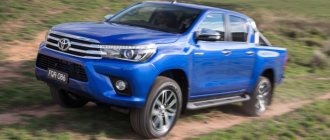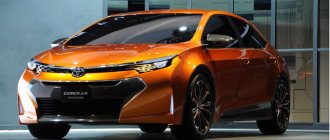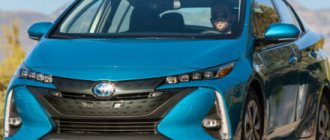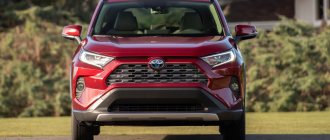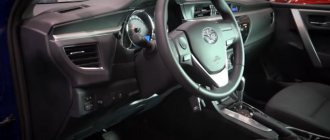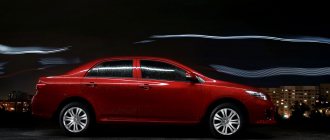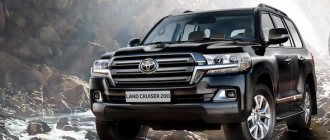A new meeting – with the already well-known Toyota Highlander crossover. And the reason for this was the addition of the word “Hybrid”: in the case of Toyota, a hybrid always means something good. And in the case of the Highlander, the hybrid version means changes not only under the hood, but also in the exterior design and interior equipment. What are we talking about? Now I'll tell you everything!
How does the Toyota Highlander hybrid crossover differ in appearance from a regular one?
Globally - yes, practically nothing. There are differences in the details. First of all, traditionally for Toyota hybrid cars, the logo has a blue background, and the characteristic “Hybrid” inscriptions are everywhere on the body. In addition, the wheel rims are different. They're still 20 inches, but now feature a striking two-tone silver and black finish. Finally, the car is notable for its details: silver inserts on the front and rear bumpers (in the 3.5-liter version they are made in dark gray tones) and chrome roof rails (instead of silver trim). In a word: connoisseurs will understand, for others it’s just a “big cross” Toyota.
By the way, the mentioned 20-inch wheels are a feature of the maximum configuration of the car. Thus, the test Toyota Highlander Hybrid crossover was presented in the Premium version - the price starts from approximately 1.7 million UAH. almost $61 thousand. The Toyota Highlander crossover with a 3.5-liter V6 in a similar Premium configuration is estimated at UAH 1.67 million. or about $60 thousand. Nominally, the price difference between them is a little more than 30 thousand UAH. However, further in the text you will understand that the Toyota Highlander Hybrid offers not only a hybrid powertrain, but also improved equipment. In addition, the hybrid crossover can be purchased in more affordable trim levels (they are currently not available for the Highlander V6): Elegance – from UAH 1.34 million. or almost $48 thousand, Prestige – from 1.52 million UAH. or a little more than $54 thousand.
A really big crossover: almost 5 meters long, 2 meters wide, soft body contours, predatory squinted headlights - by the way, fully LED in any configuration. The hybrid version is recognizable only in the details: logos and inscriptions, contrasting wheels, little details in the decor. By the way, there is an interesting dual camera nestled on the roof of the trunk...
You'll like it
93%
car owners will buy this car again!
- 88% Road tests
- 84% Reliability
- 93% Driver satisfaction
In a segment where safety, capacity and reliability are core values, the Toyota Highlander takes its rightful place. A powerful standard engine, an available hybrid model, and a long history of reliability make the Highlander a strong player in the market.
So, with appearance it’s clear. What about the interior?
Inside, the situation is similar: in general, everything is the same, but in the details there are differences. Moreover, this is the case when you like these details and differences. That's absolutely all. For example, previously the decor of the front panel and central display was made in the form of a matte gray strip. Now there is a silver insert with a structure reminiscent of scales: it feels pleasant to the touch and looks interesting. A couple more solutions are hidden from view, but are really very useful. Here is a large armrest between the front seats - it was there before. But when you open the lid, you suddenly find a wireless charger for your smartphone. Moreover, this is a separate folding niche-shelf, and under it there is also a spacious box. The second difference is the electronic rear view mirror Smart View Mirror: this is a central rear view mirror, inside of which a display is mounted and it can show a picture of what is happening behind the car. That's why a second camera was needed on the trunk lid: one for the standard rearward view, the second for the rearview mirror. But why such a mirror in principle? Yes, because the Toyota Highlander Hybrid is a family crossover with three rows of seats. Imagine the view through the mirror when all the seats are occupied by passengers/children/relatives/friends. The correct answer is “none.”
And the seats will be occupied - there will be enough space for everyone. The driver and front passenger are provided with soft armchairs that can offer heating, ventilation, and electrical adjustments. Plus excellent visibility, luxurious instruments, a convenient climate control unit, Toyota Touch 2 multimedia with an 8-inch display, data projection on the glass. Everything is so convenient that you get used to the Toyota Highlander Hybrid crossover in literally half an hour; you no longer want to scold it. Well, for example, for the steering wheel warming up only in the grip areas or for the fact that it slightly lacks the upward adjustment range.
In the rear part of the cabin there is no reason for criticism at all: a huge supply of legroom and overhead space, its own “climate” zone and heated seats, separate sofa adjustments, sun blinds on the windows. Passengers in the third row have less comfort and space, but they still “can live.” Adjusting the back angle allows you to lean back, which is subconsciously perceived as additional space. There is the minimum necessary reserve for the legs, a pair of cup holders, and you can direct the airflow. Moreover, even in the case of a 7-seater cabin, there is still some space left for luggage, and there is also somewhere to hide the roller blind. All these are little things. But believe me, it’s in these little things that the Toyota Highlander family crossover outperforms some 7-seater premium crossovers.
Traditional “Japanese interior”: you won’t find exclusive wood or premium leather here. But the inside is spacious, comfortable, and practical. And also - thought out in detail. The hybrid version can offer a couple of additional pleasant “bonuses”: original finishing of the front panel, wireless charging, and a mirror camera. Plus, contactless control of opening the trunk lid - and even with a 7-seater cabin (the third row in the “you can live” style) you will still have at least some volume and convenient niches for small things. The second row used to be spacious, and before there was a “climate”, and before there were heating, and before there were curtains. But I specifically took an additional photo to focus attention on the grilles at the base of the sofa: this is a ventilation system for the battery of the hybrid system.
New in 2021
Considering last year's restyling, the Toyota Highlander 2021 cannot boast of significant changes.
How we tested the 2018 Toyota Highlander
The basis of the Toyota Highlander Hybrid crossover is a naturally aspirated 2.5-liter gasoline engine, which is literally lost in the huge engine compartment: after all, everything was originally designed for a 3.5-liter V6! However, the final power is almost comparable. Yes, and all-wheel drive is available. But it is implemented not through a traditional driveshaft, but using a separate electric motor for the rear wheels. One of the features of the Toyota Highlander Hybrid crossover is that various tabs have been added to the displays indicating the operation of the hybrid system.
Toyota SUVs
One of the leaders on the market are Toyota frame SUVs, the list of which amazes everyone:
- Land Crusier Prado (150)
- Land Cruiser (200)
- Hilux
- Tundra
- Sequoia
- FJ Cruiser
- Fortuner
- 4Runner
Perhaps these are all the best frame SUVs from this manufacturer, each of which is worthy of attention despite the large number of differences between them.
But is it enough for off-road use? What's on the road? How about overclocking? What about the expense?
In a nutshell, the character of the Toyota Highlander (either conventional or hybrid) is comfort and regularity. And the behavior of the hybrid power unit fits perfectly into this driving character. It is soft at start, allows you to drive a little on electric power (almost silently), and transient processes are invisible here when turning on/off electric motors or a gasoline internal combustion engine. At the same time, when accelerating at an average pace and at half pedal, the car is devoid of eco-lags: where you need a pause to rev up the gasoline engine, the electric motor will take care of it. Surprisingly, constantly “floating” between connecting electric motors, a gasoline engine, or when they work together, the Toyota Highlander Hybrid crossover is quite playful and linear in driving dynamics.
You just need to get used to the fact that the sound of the internal combustion engine is no longer associated with real acceleration. Indicators of energy consumption/recovery help partly to understand what is happening: one (arrow pointer) took the place of the usual tachometer, and the second (in the form of a strip-ruler) is displayed in the head-up display combination. When the “sport” mode is activated, the car collects all available reserves - and even if it doesn’t “bullet”, it provides a quite decent 8.7 seconds to “hundreds” even on winter tires. And now attention: this result is comparable to measurements of the dynamics of the Toyota Highlander V6 - with fuel consumption 1.5-2 times lower! Thus, in the city we managed to drive consistently with a consumption of 7.5-8 liters per 100 km, and traffic jams do not particularly affect consumption: the more “taffy”, the more braking, the more often the electric motors work and help reduce consumption. With a smooth driving style, it was possible to squeeze out 5.7-6 liters per 100 km from a huge 5-meter 3-row crossover. True, on the highway the “magic of hybrid efficiency” ends: consumption at a speed of 80-90 km/h is about 6 liters per 100 km, consumption at a speed of 110-120 km/h is about 7.5 liters per 100 km.
What about off-road? Firstly, the hybrid has lost its traditional all-wheel drive, and along with it, various clutches for distributing torque and adjusting the Multi-Terrain Select driving modes for different types of off-road conditions. There's now only one Trail mode, which seems to almost always use the rear electric motor. This all-wheel drive system is called AWD-i and provides the ability to distribute torque in a ratio from 100:0 to 20:80 (between the front/rear wheels). True, active activation of the rear electric motor can be achieved in “sport” mode, but then all reactions to pressing the accelerator pedal will be sharp. And in the case of Trail, they are smoothed out as usual to prevent the wheels from suddenly slipping into slipping. Secondly, the power of the electric motor and torque of 1300 Nm at the wheels. Well, let’s put it this way: if this is “quite enough” for the RAV4, then for the Highlander it’s “minimum enough.” The rear wheels can push the car in the mud or on a dirt road, but I’m writing all this for an empty car - what will happen taking into account the passengers in the cabin and things in the trunk? Perhaps the only area in driving performance where the V6 version may be better than the hybrid is handling over rough terrain and power to the rear wheels. If you plan to drive a lot and often on serious off-road conditions (and even with a lot of people in the cabin), if you need to constantly drag a boat/trailer, then be sure to think about the capabilities of different all-wheel drive systems in different versions of the Toyota Highlander. On the other hand: the hybrid still has an additional pair of drive wheels and at least some power on the rear axle. Compared to conventional front-wheel drive, it is still an aid for normal driving on snow/ice or on forest roads. Therefore, the Toyota Highlander Hybrid may not be a rogue, but it is still a crossover with all-wheel drive.
When you try to hang a wheel, the body may creak and the gaps may shift slightly, but the doors and trunk lid open/close without problems. The rear wheels have good travel and are driven by an electric motor: this is enough to help move the car in emergency situations. Although, in general, the capabilities of the driving modes of the Toyota Highlander Hybrid crossover compared to the Highlander V6 turned out to be more modest: three options (Eco/Normal/Sport) for regular roads plus Trail for off-road conditions. However, the rest of the hybrid is good: acceleration from 0 to 100 km/h in 8.7 seconds, which is comparable to the V6 version - with almost double the fuel efficiency in the city.
Bottom line: should I buy it or not?
Now - yes, buy it. And it’s the hybrid: it deserves it. And that's why…
In the past, the Toyota Highlander crossover was just a car: everything seemed fine, but compared to the Mazda CX-9 or Infiniti QX60, it lacked some spark in character. After the change of generations, the car has really “grown”: first of all, the new Toyota Highlander crossover has become more comfortable and more modern in its equipment. This was enough to firmly take its place in the class and successfully fight with rivals, but it still lacked a decisive advantage to defeat competitors by knockout. So: this advantage turned out to be something that Toyota can do among the world leaders - a hybrid! Sufficiently powerful and amazingly economical: a real rarity in the class, which is sure to interest a huge number of buyers. Moreover, the hybrid version brought with it pleasant improvements in the configuration. Well, bravo Toyota Highlander Hybrid crossover – you really did well.
Technical characteristics of Toyota Highlander Hybrid
Body – crossover, 5 doors, 7 seats
Dimensions – 4.966 x 1.93 x 1.755 m
Wheelbase – 2.85 m
Ground clearance – 202 mm
Trunk - from 268 l (7 seats) to 1,909 l (2 seats)
Load capacity – 515-580 kg (depending on configuration)
Minimum curb weight – 2,090 kg (the exact value depends on the configuration)
Engine – hybrid, R4 2.5 l petrol engine, two electric motors
Power (total hybrid power) – 245 hp.
Specific power – 117 hp. for 1 t
Drive – AWD-i all-wheel drive (rear wheel drive from an electric motor), TRAIL mode
Transmission – e-CVT automatic, hybrid continuously variable transmission
Acceleration 0-100 km/h – 8.5 seconds
Maximum speed – 180 km/h
Fuel consumption (passport), urban cycle – 6.0 l per 100 km
Fuel consumption (passport), extra-urban cycle – 5.6 l per 100 km
Test car tires – Dunlop Grandtrek SJ8 235/55R20
The minimum price of a car is from UAH 1.34 million. or $48 thousand.
The price of the test car is about 1.7 million UAH. or $61 thousand.
Toyota 4Runner 2014
First of all, you should pay attention to the new frame SUV Toyota 4Runner 2014 - this is a kind of restyled fifth-generation model, which was presented to the consumer 4 years ago. The car now features a fresher design with angular shapes. Many improvements have been made that are aimed at improving convenience and comfort.
It is equipped with the same 4-liter engine producing 270 hp. With. At the same time, two models are offered: with all-wheel drive or plug-in drive. The interior has changed the most and the security systems have been improved. It is not yet possible to talk about the cost.


